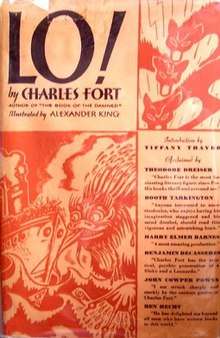Lo!
Lo! was the third published nonfiction work of the author Charles Fort (first edition 1931). In it he details a wide range of unusual phenomena. In the final chapter of the book he proposes a new cosmology that the earth is stationary in space and surrounded by a solid shell which is (in the book's final words) "... not unthinkably far away."
 First UK edition | |
| Author | Charles Hoy Fort |
|---|---|
| Language | English |
| Genre | Paranormal |
| Publisher | Claude Kendall (US) Victor Gollancz Ltd. (UK) |
Publication date | 1931 |
| Media type | Print (Hardback & Paperback) |
| Pages | 416 pp (2004 Paperback) |
| ISBN | 1-59605-028-4 (2004 Edition, Paperback) |
| OCLC | 58975446 |
| LC Class | Q173 .F715 2004 |
| Preceded by | New Lands |
| Followed by | Wild Talents |
Overview
Of Fort's four books, this volume deals most frequently and scathingly with astronomy (continuing from his previous book New Lands). The book also deals extensively with other subjects, including paranormal phenomena (see parapsychology), which were explored in his first book, The Book of the Damned. Fort is widely credited with having coined the now-popular term "teleportation" in this book, and here he ties his previous statements on what he referred to as the Super-Sargasso Sea into his beliefs on teleportation. He would later expand this theory to include purported mental and psychic phenomena in his fourth and final book, Wild Talents.
It takes its derisive title from what he regarded as the tendency of astronomers to make positivistic, overly precise, and premature announcements of celestial events and discoveries. Fort portrays them as quack prophets, sententiously pointing towards the skies and saying "Lo!"—inaccurately, as it turn out.
Lo! is arguably Fort's most popular book, perhaps due to the fact that it deals with an extremely wide and diverse range of phenomena (as can be seen below), and Fort by then had a clear theorem. His book is divided into two sections: the first on the above phenomena; the second, on his attacks on astronomy. The reason for this is that Fort had been working on a follow-up to The Book of the Damned, but he scrapped the idea and incorporated many of the subjects into this one.
Lo! is used extensively in Blue Balliett's book Chasing Vermeer.
Part One: Teleportation
Fort established his thesis for this particular book early on—that some sort of mysterious force, known as the "cosmic joker" (in his words), is responsible for the teleportation of people, animals, and materials. This thesis would be revised later to accommodate Fort's research on psychic phenomena in Wild Talents.
Fort started the book largely where he left off in The Book of the Damned: mysterious falls of animals and strange materials, flying stones, poltergeist activity, etc., and incorporated these strange phenomena into his new theory on teleportation, saying that teleportation from the Super-Sargasso Sea can explain these phenomena. Fort also briefly touched on UFOs again in this book, and wrote extensively on a number of other topics which he felt can be explained by teleportation: cryptozoology (including the Jersey Devil and various out of place animals), animal mutilations and attacks on people, strange swarming of balls, the appearance of various strange people from nowhere (the famous cases of Princess Caraboo and Kaspar Hauser), and the mysterious disappearances of others (including the diplomat Benjamin Bathurst, and vessels such as the Mary Celeste, Carroll A. Deering, and USS Cyclops, presaging later interest in the Bermuda Triangle phenomenon). He wrote an extensive chapter on the winter of 1904-5 in Britain, when a widespread religious revival in England and Wales coincided with numerous other strange occurrences: the appearances of ghosts, poltergeists, a few purported cases of Spontaneous Human Combustion, and a ravenous wolf (or perhaps werewolf) mutilating sheep and other farm animals in Northumberland.
Fort believed that all of these anomalous phenomena can be explained by his teleportation theory—though he later apparently retracted this theory to an extent in his final book.
Part Two: Astronomy
Astronomy was in vogue since the discovery of the Planet Pluto, in part by calculation.
Fort was sceptical of Albert Einstein's theories of relativity and the claim that these could be confirmed by a transit of the Sun. He was sceptical of the accuracy of the mathematics and the observations involved, and pointed out seeming contradictions and anomalies in scientists' statements to the press.
The book was recently released in a paperback version, and it is included in The Complete Works Of Charles Fort with Fort's other paranormal writings. An online version of the book is linked below.